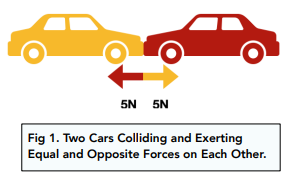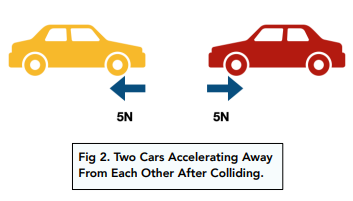Newton's Third Law (GCSE Physics)
Newton’s Third Law
Newton’s Third Law
The third law you need to know is Newton’s Third Law.

Equal and Opposite Forces
- Forces can be exerted on objects. These forces can be exerted by objects onto each other, or by other surfaces. The forces can make objects move or keep them in place.
- Newton’s Third Law states that when two objects interact, the forces they exert on each other are equal and opposite. This means that for every action, there is an equal and opposite reaction.
Example: Car Crash
An example of this is a car crash.
Car A will exert a force onto Car B, whilst Car B exerts an equal and opposite force on Car A. For example, the yellow car exerts the yellow force on the red care

The two cars may accelerate away from each other due to the impact:

Equilibrium Situations
- Equilibrium situations result in no movement. When an object is in equilibrium, it will not move as the forces are balanced. When one force acts on an object, it will be balanced out by an equal and opposite force.
- Pushing against a surface is equilibrium. When a person pushes against a surface, such as a desk, they will experience Newton’s Third Law. The person exerts a force on the desk, whilst the desk exerts and equal and opposite force on the person.





Still got a question? Leave a comment
Leave a comment